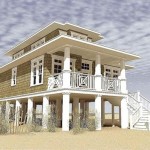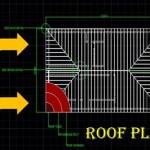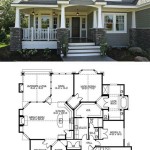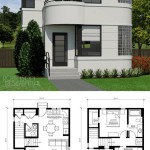Measurements Used In House Plans: A Comprehensive Guide
House plans are detailed blueprints that communicate the design and construction specifications of a residential building project. They serve as a visual representation of the future home, providing crucial information to architects, builders, contractors, and homeowners. Accurate and consistent measurements are fundamental to successful execution of any house plan. This article will explore the various types of measurements embedded in house plans, their significance, and the units of measure commonly used.
House plans consist of diverse visual elements, including floor plans, elevations, sections, and detail drawings. Each of these drawings contains specific measurements essential for understanding the spatial relationships, material quantities, and overall dimensions of the structure. The measurements displayed on these plans are derived from a variety of sources, including architectural surveys, site assessments, and the architect's design intentions. The accuracy and clarity of these measurements directly influence the building process, from initial layout to final finishes. A well-documented house plan must adhere to industry standards to ensure consistency and minimize the potential for errors.
The complexity of measurements in house plans requires a thorough understanding of various architectural conventions and notations. Understanding the scale of the drawing is the first crucial step. Scale represents the ratio between the dimensions on the plan and the actual dimensions of the building. Common scales include 1/4 inch = 1 foot, 1/8 inch = 1 foot, and 1/2 inch = 1 foot. Correctly interpreting the scale is vital for extracting accurate data from the plan. In addition to linear measurements, house plans frequently incorporate angles, elevations, and other specialized measurement types. These measurements work in coordination to define the shape, volume, and spatial characteristics of the building.
Understanding Linear Measurements
Linear measurements form the backbone of house plans, defining the lengths, widths, heights, and thicknesses of all elements within the building. These measurements are typically expressed in feet and inches in the United States, while the metric system, specifically meters and millimeters, is used in many other parts of the world. The precision with which these measurements are recorded is critical, as even small discrepancies can accumulate and lead to significant construction errors.
Floor plans rely heavily on linear measurements to indicate the dimensions of rooms, hallways, walls, and other interior spaces. These measurements are typically indicated with dimension lines, which extend parallel to the feature being measured. The dimension line is terminated with arrowheads or tick marks at the points being measured, and a numerical value is placed above or below the line, indicating the length. In some cases, the dimension line might include a break to accommodate the numerical value. The placement of dimension lines follows specific conventions to ensure clarity and avoid ambiguity. Dimensions are placed outside the walls being dimensioned, whenever possible so as not to clutter the interior space of the plan.
External dimensions, also linear, are extremely important. They determine the overall footprint of the building on the lot, as well as the placement of doors, windows, and other exterior components. These dimensions are often tied to property lines, setbacks, and other regulatory requirements. Exterior wall thicknesses also affect internal space dimensions. Elevations, which are orthogonal projections of the building's facades, also rely on linear measurements to indicate the height of walls, roofs, windows, and doors. These measurements are usually taken from a known datum, which is a reference point that serves as the baseline for all vertical measurements.
Wall thickness is crucial for structural integrity and insulation performance. Different types of walls (e.g., load-bearing, partition, exterior) have varying thickness requirements, which are clearly specified in the house plan. Interior walls, in contrast, are usually thinner, but they still affect the usable space within the building. The accurate measurement and representation of these thicknesses are important for calculating material quantities and ensuring compliance with building codes.
Elevation and Vertical Measurements
Elevations and vertical measurements are crucial for understanding the vertical aspects of a house design. They depict the exterior facades of the building and indicate the heights of walls, roofs, windows, doors, and other architectural elements. These measurements are typically taken from a known datum, such as the finished floor elevation (FFE), which serves as the reference point for all vertical dimensions.
Elevations often include notes such as “top of wall” (TOW), “bottom of window” (BOW), or “top of foundation” (TOF). These notes, along with the associated measurements, help builders and contractors understand the precise vertical positioning of each element. In addition to showing the height of vertical elements, elevations also indicate the slope of roofs and the pitch of stairs. Roof pitch is commonly expressed as a ratio, such as 6:12, which means that for every 12 inches of horizontal run, the roof rises 6 inches vertically. Stair pitch is determined by the rise and run of the individual steps.
Floor-to-floor height is a critical vertical measurement that impacts the overall volume of the building. This measurement is taken from the finished floor of one level to the finished floor of the level above. It directly affects the headroom within each room and the placement of interior elements such as lighting fixtures and ceiling fans. In addition to the overall floor-to-floor height, house plans may also indicate ceiling heights, which are the distance from the finished floor to the finished ceiling. These measurements are important for creating comfortable and functional living spaces. Ceiling heights are often varied within a house to create different spatial effects.
Site plans, which depict the building's relationship to the surrounding property, also incorporate vertical measurements. These measurements indicate the grade of the land, the location of utilities, and the finished floor elevation of the building. They are especially important for ensuring proper drainage and accessibility. The site plan also indicates the elevation of key features such as sidewalks, driveways, and landscaping elements. These elevations are carefully coordinated to ensure that the building is properly integrated into the surrounding landscape.
Angles and Specialized Measurements
While linear and vertical measurements are predominantly used in house plans, angles and specialized measurements also play a significant role. Angles are crucial for defining the shape of roofs, walls, and other architectural elements. Specialized measurements, such as radii and curves, are used to define curved walls, arches, and other non-linear features.
Roof angles are critical for determining the structural integrity and aesthetic appearance of the building. Steeply pitched roofs are more effective at shedding snow and water, while shallow-pitched roofs may be more suitable for certain architectural styles. The angle of the roof is carefully calculated to ensure that it meets both functional and aesthetic requirements. In addition to roof angles, house plans may also indicate the angles of walls, especially in corner conditions. These angles are carefully measured to ensure that the walls are properly aligned and that the building has a consistent and balanced appearance.
Radii and curves are used to define curved walls, arches, and other non-linear features. These measurements require special attention to detail, as they cannot be accurately represented with simple linear dimensions. The radius of a curve is the distance from the center of the curve to any point on the curve's edge. The length of the curve, or arc length, is another important measurement. These measurements are carefully calculated and indicated on the house plan to ensure that the curved features are constructed accurately.
House plans can include specialized measurements. Area calculations are used to determine the square footage of rooms, floors, and the overall building. These calculations are important for estimating material quantities, determining property taxes, and complying with building codes. Volume calculations are used to determine the cubic footage of spaces, which is important for heating, ventilation, and air conditioning (HVAC) system design. Specialized notations and symbols are also used on house plans to indicate the location of electrical outlets, plumbing fixtures, and other mechanical components. These notations are standardized to ensure that they are easily understood by all construction professionals involved in the project.
In summary, the accurate interpretation and utilization of measurements within house plans are essential for the successful planning and execution of residential building projects. Understanding linear, vertical, angular, and specialized measurements, along with their corresponding notations and units, provides a solid foundation for effective communication between architects, builders, contractors, and homeowners. Attention to detail in measurement interpretation and application ensures accuracy in construction, reduces the likelihood of errors, and contributes to the creation of a well-designed and functional living space.

How To Calculate House Plan Measurements Read Floor Estimate The Dimensions Of Your

A Floorplan Of Single Family House All Dimensions In Meters Scientific Diagram

How To Read Floor Plans

How To Read A House Plan With Dimensions Riverfront Custom Homes

12 Examples Of Floor Plans With Dimensions

12 Examples Of Floor Plans With Dimensions

How To Read Floor Plans With Dimensions A Guide

How To Read A Floor Plan With Dimensions Houseplans Blog Com

How To Add Floor Plan Measurements In Roomsketcher

Part 1 Floor Plan Measurements Small House Design And Framing
Related Posts








